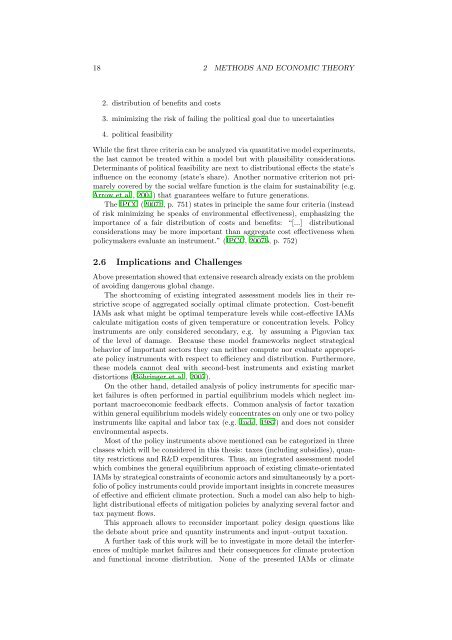Modeling Climate Policy Instruments in a Stackelberg Game with ...
Modeling Climate Policy Instruments in a Stackelberg Game with ...
Modeling Climate Policy Instruments in a Stackelberg Game with ...
You also want an ePaper? Increase the reach of your titles
YUMPU automatically turns print PDFs into web optimized ePapers that Google loves.
18 2 METHODS AND ECONOMIC THEORY<br />
2. distribution of benefits and costs<br />
3. m<strong>in</strong>imiz<strong>in</strong>g the risk of fail<strong>in</strong>g the political goal due to uncerta<strong>in</strong>ties<br />
4. political feasibility<br />
While the first three criteria can be analyzed via quantitative model experiments,<br />
the last cannot be treated <strong>with</strong><strong>in</strong> a model but <strong>with</strong> plausibility considerations.<br />
Determ<strong>in</strong>ants of political feasibility are next to distributional effects the state’s<br />
<strong>in</strong>fluence on the economy (state’s share). Another normative criterion not primarely<br />
covered by the social welfare function is the claim for susta<strong>in</strong>ability (e.g.<br />
Arrow et al., 2004) that guarantees welfare to future generations.<br />
The IPCC (2007b, p. 751) states <strong>in</strong> pr<strong>in</strong>ciple the same four criteria (<strong>in</strong>stead<br />
of risk m<strong>in</strong>imiz<strong>in</strong>g he speaks of environmental effectiveness), emphasiz<strong>in</strong>g the<br />
importance of a fair distribution of costs and benefits: “[...] distributional<br />
considerations may be more important than aggregate cost effectiveness when<br />
policymakers evaluate an <strong>in</strong>strument.” (IPCC, 2007b, p. 752)<br />
2.6 Implications and Challenges<br />
Above presentation showed that extensive research already exists on the problem<br />
of avoid<strong>in</strong>g dangerous global change.<br />
The shortcom<strong>in</strong>g of exist<strong>in</strong>g <strong>in</strong>tegrated assessment models lies <strong>in</strong> their restrictive<br />
scope of aggregated socially optimal climate protection. Cost-benefit<br />
IAMs ask what might be optimal temperature levels while cost-effective IAMs<br />
calculate mitigation costs of given temperature or concentration levels. <strong>Policy</strong><br />
<strong>in</strong>struments are only considered secondary, e.g. by assum<strong>in</strong>g a Pigovian tax<br />
of the level of damage. Because these model frameworks neglect strategical<br />
behavior of important sectors they can neither compute nor evaluate appropriate<br />
policy <strong>in</strong>struments <strong>with</strong> respect to efficiency and distribution. Furthermore,<br />
these models cannot deal <strong>with</strong> second-best <strong>in</strong>struments and exist<strong>in</strong>g market<br />
distortions (Böhr<strong>in</strong>ger et al., 2007).<br />
On the other hand, detailed analysis of policy <strong>in</strong>struments for specific market<br />
failures is often performed <strong>in</strong> partial equilibrium models which neglect important<br />
macroeconomic feedback effects. Common analysis of factor taxation<br />
<strong>with</strong><strong>in</strong> general equilibrium models widely concentrates on only one or two policy<br />
<strong>in</strong>struments like capital and labor tax (e.g. Judd, 1987) and does not consider<br />
environmental aspects.<br />
Most of the policy <strong>in</strong>struments above mentioned can be categorized <strong>in</strong> three<br />
classes which will be considered <strong>in</strong> this thesis: taxes (<strong>in</strong>clud<strong>in</strong>g subsidies), quantity<br />
restrictions and R&D expenditures. Thus, an <strong>in</strong>tegrated assessment model<br />
which comb<strong>in</strong>es the general equilibrium approach of exist<strong>in</strong>g climate-orientated<br />
IAMs by strategical constra<strong>in</strong>ts of economic actors and simultaneously by a portfolio<br />
of policy <strong>in</strong>struments could provide important <strong>in</strong>sights <strong>in</strong> concrete measures<br />
of effective and efficient climate protection. Such a model can also help to highlight<br />
distributional effects of mitigation policies by analyz<strong>in</strong>g several factor and<br />
tax payment flows.<br />
This approach allows to reconsider important policy design questions like<br />
the debate about price and quantity <strong>in</strong>struments and <strong>in</strong>put–output taxation.<br />
A further task of this work will be to <strong>in</strong>vestigate <strong>in</strong> more detail the <strong>in</strong>terferences<br />
of multiple market failures and their consequences for climate protection<br />
and functional <strong>in</strong>come distribution. None of the presented IAMs or climate
















